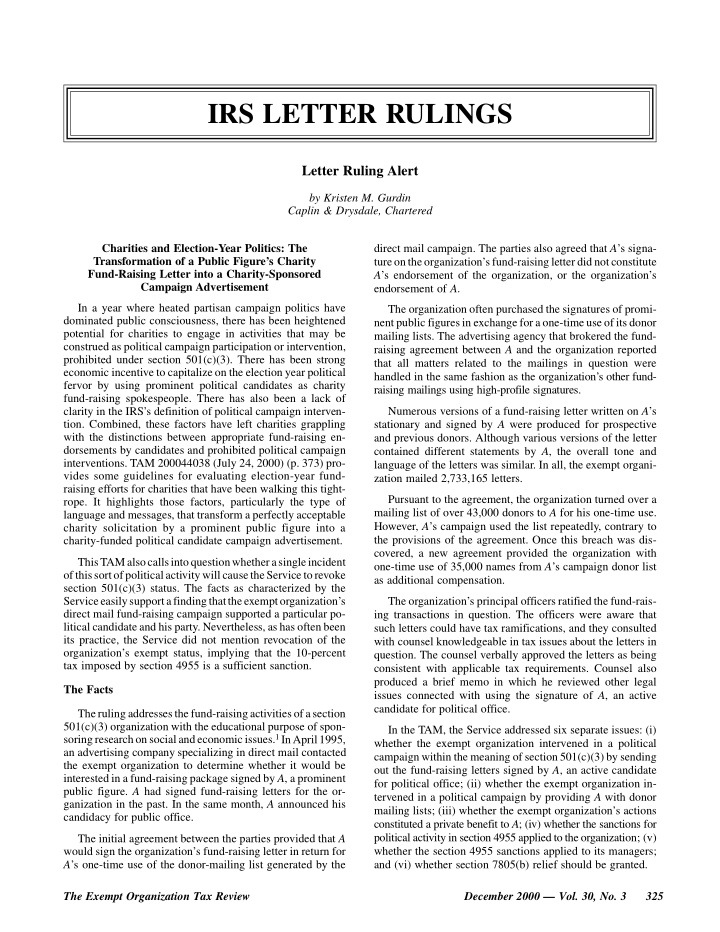



IRS LETTER RULINGS Letter Ruling Alert by Kristen M. Gurdin Caplin & Drysdale, Chartered Charities and Election-Year Politics: The direct mail campaign. The parties also agreed that A ’s signa- Transformation of a Public Figure’s Charity ture on the organization’s fund-raising letter did not constitute Fund-Raising Letter into a Charity-Sponsored A ’s endorsement of the organization, or the organization’s Campaign Advertisement endorsement of A . In a year where heated partisan campaign politics have The organization often purchased the signatures of promi- dominated public consciousness, there has been heightened nent public figures in exchange for a one-time use of its donor potential for charities to engage in activities that may be mailing lists. The advertising agency that brokered the fund- construed as political campaign participation or intervention, raising agreement between A and the organization reported prohibited under section 501(c)(3). There has been strong that all matters related to the mailings in question were economic incentive to capitalize on the election year political handled in the same fashion as the organization’s other fund- fervor by using prominent political candidates as charity raising mailings using high-profile signatures. fund-raising spokespeople. There has also been a lack of clarity in the IRS’s definition of political campaign interven- Numerous versions of a fund-raising letter written on A ’s tion. Combined, these factors have left charities grappling stationary and signed by A were produced for prospective with the distinctions between appropriate fund-raising en- and previous donors. Although various versions of the letter dorsements by candidates and prohibited political campaign contained different statements by A , the overall tone and interventions. TAM 200044038 (July 24, 2000) (p. 373) pro- language of the letters was similar. In all, the exempt organi- vides some guidelines for evaluating election-year fund- zation mailed 2,733,165 letters. raising efforts for charities that have been walking this tight- Pursuant to the agreement, the organization turned over a rope. It highlights those factors, particularly the type of mailing list of over 43,000 donors to A for his one-time use. language and messages, that transform a perfectly acceptable However, A ’s campaign used the list repeatedly, contrary to charity solicitation by a prominent public figure into a charity-funded political candidate campaign advertisement. the provisions of the agreement. Once this breach was dis- covered, a new agreement provided the organization with This TAM alsocallsinto question whetherasingleincident one-time use of 35,000 names from A ’s campaign donor list of this sort of political activity will cause the Service to revoke as additional compensation. section 501(c)(3) status. The facts as characterized by the Service easilysupport a finding thatthe exempt organization’s The organization’s principal officers ratified the fund-rais- direct mail fund-raising campaign supported a particular po- ing transactions in question. The officers were aware that litical candidate and his party. Nevertheless, as has often been such letters could have tax ramifications, and they consulted its practice, the Service did not mention revocation of the with counsel knowledgeable in tax issues about the letters in organization’s exempt status, implying that the 10-percent question. The counsel verbally approved the letters as being tax imposed by section 4955 is a sufficient sanction. consistent with applicable tax requirements. Counsel also produced a brief memo in which he reviewed other legal The Facts issues connected with using the signature of A , an active candidate for political office. The ruling addresses the fund-raising activities of a section 501(c)(3) organization with the educational purpose of spon- In the TAM, the Service addressed six separate issues: (i) soring research on social and economic issues. 1 In April 1995, whether the exempt organization intervened in a political an advertising company specializing in direct mail contacted campaign within the meaning of section 501(c)(3) by sending the exempt organization to determine whether it would be out the fund-raising letters signed by A , an active candidate interested in a fund-raising package signed by A , a prominent for political office; (ii) whether the exempt organization in- public figure. A had signed fund-raising letters for the or- tervened in a political campaign by providing A with donor ganization in the past. In the same month, A announced his mailing lists; (iii) whether the exempt organization’s actions candidacy for public office. constituted a private benefit to A ; (iv) whether the sanctions for political activity in section 4955 applied to the organization; (v) The initial agreement between the parties provided that A whether the section 4955 sanctions applied to its managers; would sign the organization’s fund-raising letter in return for A ’s one-time use of the donor-mailing list generated by the and (vi) whether section 7805(b) relief should be granted. The Exempt Organization Tax Review December 2000 — Vol. 30, No. 3 325
Recommend
More recommend